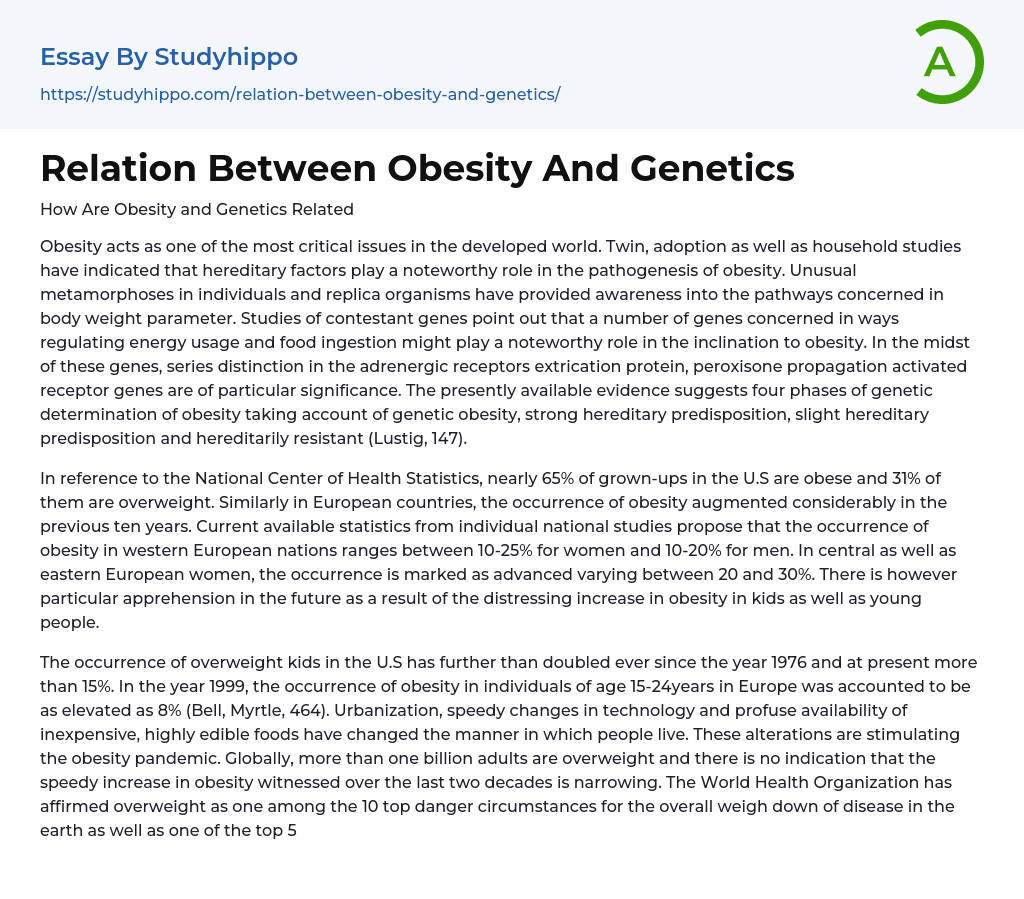Obesity and Genetics: A Strong Connection
The link between obesity and genetics is extensively documented, especially in developed nations. Environmental factors also have a role in the development of obesity. Studies involving twins, adopted individuals, and families have demonstrated that genetics play a significant role in obesity development. Scientists have focused on examining the genetic makeup of various organisms to comprehend how specific pathways regulate body weight. Through this research, genes related to energy metabolism and food intake have been identified as potential influencers of predisposition to obesity. Notably, adrenergic receptors extrication protein and peroxisone propagation activated receptor genes are particularly important for understanding this connection.
According to Lustig (147), there are four genetic determination phases of obesity: genetic obesity, strong hereditary predisposition, slight hereditary predisposition, and he
...reditarily resistant. The National Center of Health Statistics states that approximately 65% of adults in the U.S. are obese and 31% are overweight. In recent years, European countries have seen a significant increase in obesity prevalence. Recent national studies show that women in western European nations have obesity rates ranging from 10-25%, while men range from 10-20%. In central and eastern Europe, the occurrence of obesity among women is even higher at 20-30%.
Concerns about the future arise from the alarming rise in obesity among children and young people. In the United States, the percentage of overweight children has more than doubled since 1976, reaching over 15%. Europe also saw high rates of obesity among individuals aged 15-24, with a prevalence as high as 8% in 1999 (Bell, Myrtle, 464). Lifestyles have been significantly influenced by urbanization, rapid technological advancements, and easily accessible cheap and highly palatable foods. These factors hav
contributed to the global obesity epidemic. The number of overweight adults worldwide has surpassed one billion without any indication that the rapid growth in obesity witnessed over the past two decades will slow down.
The World Health Organization has classified overweight as a significant risk factor for global disease burden, ranking it in the top 10. In developed nations, it is among the top 5 risk factors. Obesity occurs due to an imbalance in energy levels, influenced by genetic predisposition and environmental factors. The long-term connection between energy intake, expenditure, nutrient distribution, and adiposity determines the amount of stored energy in the body. When there is a consistent surplus of energy intake compared to expenditure and when fuel distribution favors storing lipids and oxidizing carbohydrates, fat cells increase leading to overall body fat gain.
Both lifestyle and ecological factors contribute to the acknowledged determinants of obesity, but genetic associations also play a significant role. These genetic associations interact with important environmental factors, highlighting the importance of an obesogenic environment for obesity to manifest. Hence, genes and the environment have a dependent relationship where the severity of obesity greatly relies on lifestyle and environmental conditions when there is a genetic predisposition.
Is Obesity a Genetic Disorder
The question of whether obesity is caused by genetics arises due to the significant suffering and financial consequences linked to this persistent condition. Obesity amplifies the likelihood of various health issues including diabetes, hypertension, asthma, heart disease, sleep apnoea, cancer, and osteoarthritis. In uncommon instances, obesity can be ascribed to a particular gene mutation that impacts the body's energy balance and thus becomes an inherited disorder. The severity of this condition stems from both
genetic factors and environmental factors (Grant, 98).
The observation that an individual recombinant protein can reverse obesity caused by a single-gene transformation is intriguing. However, it is challenging to identify cases of genetic obesity due to the need for evaluating multiple genes. Based on available data, hereditary obesity appears to contribute to at least 5% of all obesity cases and a significant portion of extremely obese individuals. Widespread obesity can be categorized into two groups: those with a strong genetic predisposition and those with a minor genetic vulnerability. Unlike the former group, individuals with a strong genetic predisposition do not have an identifiable biological issue solely attributed to one gene or transformation.
In an obesogenic environment, individuals are at risk of becoming overweight and potentially severely obese. The current obesity epidemic cannot be solely attributed to changes in genetics. Rather, it is more likely a result of the surrounding environment that encourages consumption and discourages energy-expending behaviors. This leads to maladaptive behaviors that contribute to obesity.
Conclusion
The rapid increase in weight within the population over the past three decades is not due to biological flaws but rather the influence of an obesogenic setting.
Work cited
- Bell, Myrtle P. Diversity in Organizations. Mason, Ohio: South-Western College, 2012. Print.
- Grant, Struan. Genetics of Obesity. S.l.: SPRINGER-VERLAG NEW YORK, 2016. Print.
- Lustig, Robert H. Obesity Before Birth: Maternal and Prenatal Influences on the Offspring. New York: Springer Science+Business Media, LLC, 2011print
- Anatomy and Physiology essays
- Addiction essays
- Biodegradation essays
- Dental Care essays
- Disease essays
- Disorders essays
- Health Care essays
- Intelligence Quotient essays
- Nutrition essays
- Olfaction essays
- Public Health essays
- Women's Health essays
- World health organization essays
- Cancer essays
- Infectious Disease essays
- Lung Cancer essays
- Neurology essays
- Physical Exercise essays
- Medicine essays
- Sex essays
- Inquiry essays
- Disability essays
- Poison essays
- Action Potential essays
- Nervous System essays
- Childbirth essays
- Puberty essays
- Blood essays
- Kidney essays
- Neuron essays
- Body essays
- Glucose essays
- Sense essays
- Heart essays
- Skeleton essays
- Human Physiology essays
- Eye essays
- Immune System essays
- Muscle essays
- Skin essays
- Brain essays
- Central Nervous System essays
- Human Skin Color essays
- Digestive System essays
- Common sense essays
- Respiration essays
- alcoholism essays
- Smoking essays
- Casino essays
- Tobacco essays




